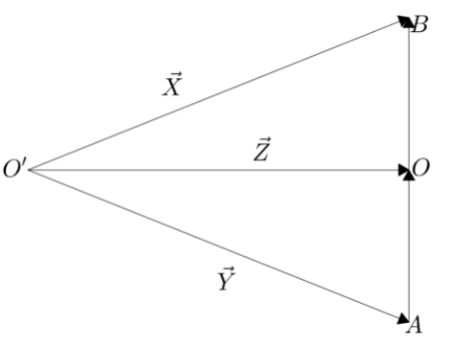
Five vectors $\overrightarrow{X}$ , $\overrightarrow{Y}$ , $\overrightarrow{Z}$ , $\overrightarrow{OA}$ , and $\overrightarrow{OB}$ are connected as shown in figure. If $\overrightarrow{OB}=\overrightarrow{AO}$, then which of the following options is correct.
A. $\overrightarrow{X}+\overrightarrow{Y}=2\overrightarrow{Z}$
B. $\overrightarrow{X}-\overrightarrow{Y}=2\overrightarrow{Z}$
C. $\overrightarrow{X}-\overrightarrow{Y}=3\overrightarrow{Z}$
D. $\overrightarrow{Y}+\overrightarrow{Z}=2\overrightarrow{X}$


Answer
500.7k+ views
Hint: Use triangle law of vector addition and properties of vector like associative law, commutative law, identity law, additive inverse etc. Vector is a physical quantity that has both magnitude and direction. It is represented by an arrow whose direction is same as that of quantity and whose length is proportional to the quantity’s magnitude.
Complete step by step answer:
Here, as we are given vectors, we can use the triangle law of vector addition. According to triangle law of vector addition, when two vectors are represented as two sides of the triangle with order of magnitude and direction, then the third side of the triangle represents the magnitude and direction of the resultant vector.Let us consider the triangle $\Delta O'OB$ . For this triangle, using triangle law of vector addition we can understand that $\overrightarrow{Z}+\overrightarrow{OB}=\overrightarrow{X}$
Rearranging the equation as $\overrightarrow{OB}=\overrightarrow{X}-\overrightarrow{Z}$ …… $(1)$
Similarly for the triangle $\Delta O'AO$ , using the triangle law of vector addition, we can obtain the relation as $\overrightarrow{Y}+\overrightarrow{OA}=\overrightarrow{Z}$
Rearranging the equation as $\overrightarrow{OA}=\overrightarrow{Z}-\overrightarrow{Y}$ …… $(2)$
Now, we are given here that $\overrightarrow{OB}=\overrightarrow{AO}$
Hence, we can say that the left hand side of the equations are equal.
Thus, we can equate the right hand sides of both equations
$\overrightarrow{X}-\overrightarrow{Z}=\overrightarrow{Z}-\overrightarrow{Y}$
$\therefore \overrightarrow{X}+\overrightarrow{Y}=2\overrightarrow{Z}$
Hence, the correct answer is option A.
Note: For triangle law of vector addition, we must remember to consider the vector which starts from the head of the first vector as the second vector. And the resultant vector will be the vector which starts from the origin of the first vector and intersects at the head of the second vector.
Complete step by step answer:
Here, as we are given vectors, we can use the triangle law of vector addition. According to triangle law of vector addition, when two vectors are represented as two sides of the triangle with order of magnitude and direction, then the third side of the triangle represents the magnitude and direction of the resultant vector.Let us consider the triangle $\Delta O'OB$ . For this triangle, using triangle law of vector addition we can understand that $\overrightarrow{Z}+\overrightarrow{OB}=\overrightarrow{X}$
Rearranging the equation as $\overrightarrow{OB}=\overrightarrow{X}-\overrightarrow{Z}$ …… $(1)$
Similarly for the triangle $\Delta O'AO$ , using the triangle law of vector addition, we can obtain the relation as $\overrightarrow{Y}+\overrightarrow{OA}=\overrightarrow{Z}$
Rearranging the equation as $\overrightarrow{OA}=\overrightarrow{Z}-\overrightarrow{Y}$ …… $(2)$
Now, we are given here that $\overrightarrow{OB}=\overrightarrow{AO}$
Hence, we can say that the left hand side of the equations are equal.
Thus, we can equate the right hand sides of both equations
$\overrightarrow{X}-\overrightarrow{Z}=\overrightarrow{Z}-\overrightarrow{Y}$
$\therefore \overrightarrow{X}+\overrightarrow{Y}=2\overrightarrow{Z}$
Hence, the correct answer is option A.
Note: For triangle law of vector addition, we must remember to consider the vector which starts from the head of the first vector as the second vector. And the resultant vector will be the vector which starts from the origin of the first vector and intersects at the head of the second vector.
Recently Updated Pages
Why are manures considered better than fertilizers class 11 biology CBSE

Find the coordinates of the midpoint of the line segment class 11 maths CBSE

Distinguish between static friction limiting friction class 11 physics CBSE

The Chairman of the constituent Assembly was A Jawaharlal class 11 social science CBSE

The first National Commission on Labour NCL submitted class 11 social science CBSE

Number of all subshell of n + l 7 is A 4 B 5 C 6 D class 11 chemistry CBSE

Trending doubts
What is meant by exothermic and endothermic reactions class 11 chemistry CBSE

1 Quintal is equal to a 110 kg b 10 kg c 100kg d 1000 class 11 physics CBSE

What is periodicity class 11 chemistry CBSE

What is a periderm How does periderm formation take class 11 biology CBSE

Mention the basic forces in nature class 11 physics CBSE

What are porins class 11 biology CBSE




